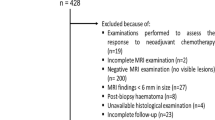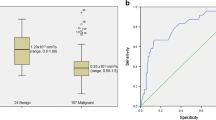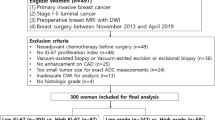Abstract
Purpose
To evaluate whether the variation of the apparent diffusion coefficient (ADC) values obtained with DWI can predict elevated levels of Ki67 proliferation index and aggressive subtypes in patients with breast cancer.
Materials and methods
Breast MRI studies of 115 patients (mean age 57.3 years, range 36–81 years) with a biopsy-proven breast cancers were evaluated in this retrospective IRB-approved study. Examinations were performed on a 1.5 T magnet and included a Single-Shot Echoplanar DWI sequence with b values of 0 and 1000 s/mm2. For each target lesion, ADC was measured. ADC values were compared considering Ki67 status (≥20 % or <20 %), histology, grade (G1, G2 or G3) and clinical–pathological classification (Luminal A, Luminal B HER2-positive, Luminal B HER-2 negative, HER-2 enriched and Triple Negative). Mann–Whitney U test and Kruskal–Wallis test were used for comparisons and receiver operating characteristic (ROC) curves were obtained. Inter- and intra-reader variability was evaluated in a subset of 40 patients, using interclass correlation coefficient (ICC) and Bland–Altman plots.
Results
Of 115 lesions, 53 (46.1 %) were assessed as Ki67 positive and 62 (53.9 %) as Ki67 negative. ADC values were significantly (p < 0.0001) lower in Ki67-positive patients (median 0.86 × 10−3 mm2/s; interquartile range 0.75–0.92) compared to Ki67-negative (median 1.03 × 10−3 mm2/s; interquartile range 0.92–1.13). Median ADC was also lower in G2 and G3 cancer and in the Luminal B Her2-negative subtype (p = 0.0015). No differences were found when evaluating histology. ROC curve showed a sensitivity and specificity of 83.0 and 66.1 %, respectively, when using a cutoff of 0.95 s/mm2 to differentiate Ki67-positive from Ki67-negative cancers. Inter- and intra-reader variability was moderate (ICC = 0.623; ICC = 0.548, respectively). No systematic differences were identified with Bland–Altman plots.
Conclusions
Lower ADC values are associated with elevated Ki67 proliferation index and more aggressive pathologic features. Moderate agreement in ADC measurement could be a limitation.




Similar content being viewed by others
References
Lakhani SR, Ellis IO, Schnitt SJ, et al. (2012) WHO classification of tumours, Volume 4 IARC WHO classification of tumours, No 4, IARC. Lyon
Guiu S, Michiels S, André F et al (2012) Molecular subclasses of breast cancer: how do we define them? The IMPAKT 2012 Working Group Statement. Ann Oncol 23:2997–3006. doi:10.1093/annonc/mds586
Goldhirsch A, Winer EP, Coates AS et al (2013) Personalizing the treatment of women with early breast cancer: highlights of the St Gallen International Expert Consensus on the Primary Therapy of Early Breast Cancer 2013. Ann Oncol 24:2206–2223. doi:10.1093/annonc/mdt303
Kuhl CK, Schrading S, Bieling HB et al (2007) MRI for diagnosis of pure ductal carcinoma in situ: a prospective observational study. Lancet 370:485–492. doi:10.1016/S0140-6736(07)61232-X
Houssami N, Ciatto S, Macaskill P et al (2008) Accuracy and surgical impact of magnetic resonance imaging in breast cancer staging: systematic review and meta-analysis in detection of multifocal and multicentric cancer. J Clin Oncol 26:3248–3258. doi:10.1200/JCO.2007.15.2108
Benndorf M, Baltzer PAT, Vag T et al (2010) Breast MRI as an adjunct to mammography: does it really suffer from low specificity? A retrospective analysis stratified by mammographic BI-RADS classes. Acta Radiol Stockh Swed 51:715–721. doi:10.3109/02841851.2010.497164
Weissleder R, Pittet MJ (2008) Imaging in the era of molecular oncology. Nature 452:580–589. doi:10.1038/nature06917
Guo Y, Cai Y-Q, Cai Z-L et al (2002) Differentiation of clinically benign and malignant breast lesions using diffusion-weighted imaging. J Magn Reson Imaging 16:172–178. doi:10.1002/jmri.10140
Tsushima Y, Takahashi-Taketomi A, Endo K (2009) Magnetic resonance (MR) differential diagnosis of breast tumors using apparent diffusion coefficient (ADC) on 1.5-T. J Magn Reson Imaging 30:249–255. doi:10.1002/jmri.21854
Kinoshita T, Yashiro N, Ihara N et al (2002) Diffusion-weighted half-Fourier single-shot turbo spin echo imaging in breast tumors: differentiation of invasive ductal carcinoma from fibroadenoma. J Comput Assist Tomogr 26:1042–1046
Partridge SC, McDonald ES (2013) Diffusion weighted magnetic resonance imaging of the breast: protocol optimization, interpretation, and clinical applications. Magn Reson Imaging Clin N Am 21:601–624. doi:10.1016/j.mric.2013.04.007
Dorrius MD, Dijkstra H, Oudkerk M, Sijens PE (2014) Effect of b value and pre-admission of contrast on diagnostic accuracy of 1.5-T breast DWI: a systematic review and meta-analysis. Eur Radiol 24:2835–2847. doi:10.1007/s00330-014-3338-z
Li X-R, Cheng L-Q, Liu M et al (2012) DW-MRI ADC values can predict treatment response in patients with locally advanced breast cancer undergoing neoadjuvant chemotherapy. Med Oncol Northwood Lond Engl 29:425–431. doi:10.1007/s12032-011-9842-y
Fangberget A, Nilsen LB, Hole KH et al (2011) Neoadjuvant chemotherapy in breast cancer-response evaluation and prediction of response to treatment using dynamic contrast-enhanced and diffusion-weighted MR imaging. Eur Radiol 21:1188–1199. doi:10.1007/s00330-010-2020-3
Elston CW, Ellis IO (1991) Pathological prognostic factors in breast cancer. I. The value of histological grade in breast cancer: experience from a large study with long-term follow-up. Histopathology 19:403–410
Wolff AC, Hammond MEH, Schwartz JN et al (2007) American Society of Clinical Oncology/College of American Pathologists guideline recommendations for human epidermal growth factor receptor 2 testing in breast cancer. J Clin Oncol Off J Am Soc Clin Oncol 25:118–145. doi:10.1200/JCO.2006.09.2775
Kuroki Y, Nasu K, Kuroki S et al (2004) Diffusion-weighted imaging of breast cancer with the sensitivity encoding technique: analysis of the apparent diffusion coefficient value. Magn Reson Med Sci 3:79–85. doi:10.2463/mrms.3.79
Park MJ, Cha ES, Kang BJ et al (2007) The role of diffusion-weighted imaging and the apparent diffusion coefficient (ADC) values for breast tumors. Korean J Radiol 8:390–396. doi:10.3348/kjr.2007.8.5.390
Martincich L, Deantoni V, Bertotto I et al (2012) Correlations between diffusion-weighted imaging and breast cancer biomarkers. Eur Radiol 22:1519–1528. doi:10.1007/s00330-012-2403-8
Dowsett M, Nielsen TO, A’Hern R et al (2011) Assessment of Ki67 in Breast cancer: recommendations from the International Ki67 in Breast Cancer Working Group. JNCI J Natl Cancer Inst 103:1656–1664. doi:10.1093/jnci/djr393
Luporsi E, André F, Spyratos F et al (2012) Ki-67: level of evidence and methodological considerations for its role in the clinical management of breast cancer: analytical and critical review. Breast Cancer Res Treat 132:895–915. doi:10.1007/s10549-011-1837-z
Jansen RL, Hupperets PS, Arends JW et al (1998) MIB-1 labelling index is an independent prognostic marker in primary breast cancer. Br J Cancer 78:460–465
Heo SH, Jeong YY, Shin SS et al (2010) Apparent diffusion coefficient value of diffusion-weighted imaging for hepatocellular carcinoma: correlation with the histologic differentiation and the expression of vascular endothelial growth factor. Korean J Radiol 11:295–303. doi:10.3348/kjr.2010.11.3.295
Muraoka N, Uematsu H, Kimura H et al (2008) Apparent diffusion coefficient in pancreatic cancer: characterization and histopathological correlations. J Magn Reson Imaging JMRI 27:1302–1308. doi:10.1002/jmri.21340
Rosenkrantz AB, Niver BE, Fitzgerald EF et al (2010) Utility of the apparent diffusion coefficient for distinguishing clear cell renal cell carcinoma of low and high nuclear grade. Am J Roentgenol 195:W344–W351. doi:10.2214/AJR.10.4688
Choi SY, Chang Y-W, Park HJ et al (2012) Correlation of the apparent diffusion coefficiency values on diffusion-weighted imaging with prognostic factors for breast cancer. Br J Radiol 85:e474–e479. doi:10.1259/bjr/79381464
Onishi N, Kanao S, Kataoka M et al (2014) Apparent diffusion coefficient as a potential surrogate marker for Ki-67 index in mucinous breast carcinoma. J Magn Reson Imaging JMRI. doi:10.1002/jmri.24615
Jeh SK, Kim SH, Kim HS et al (2011) Correlation of the apparent diffusion coefficient value and dynamic magnetic resonance imaging findings with prognostic factors in invasive ductal carcinoma. J Magn Reson Imaging JMRI 33:102–109. doi:10.1002/jmri.22400
Kim SH, Cha ES, Kim HS et al (2009) Diffusion-weighted imaging of breast cancer: correlation of the apparent diffusion coefficient value with prognostic factors. J Magn Reson Imaging JMRI 30:615–620. doi:10.1002/jmri.21884
Mori N, Ota H, Mugikura S et al (2015) Luminal-type breast cancer: correlation of apparent diffusion coefficients with the Ki-67 labeling index. Radiology 274:66–73. doi:10.1148/radiol.14140283
Razek AAKA, Gaballa G, Denewer A, Nada N (2010) Invasive ductal carcinoma: correlation of apparent diffusion coefficient value with pathological prognostic factors. NMR Biomed 23:619–623. doi:10.1002/nbm.1503
Costantini M, Belli P, Rinaldi P et al (2010) Diffusion-weighted imaging in breast cancer: relationship between apparent diffusion coefficient and tumour aggressiveness. Clin Radiol 65:1005–1012. doi:10.1016/j.crad.2010.07.008
De Felice C, Cipolla V, Guerrieri D et al (2014) Apparent diffusion coefficient on 3.0 Tesla magnetic resonance imaging and prognostic factors in breast cancer. Eur J Gynaecol Oncol 35:408–414
Kamitani T, Matsuo Y, Yabuuchi H et al (2013) Correlations between apparent diffusion coefficient values and prognostic factors of breast cancer. Magn Reson Med Sci 12:193–199
Petralia G, Bonello L, Summers P et al (2011) Intraobserver and interobserver variability in the calculation of apparent diffusion coefficient (ADC) from diffusion-weighted magnetic resonance imaging (DW-MRI) of breast tumours. Radiol Med (Torino) 116:466–476. doi:10.1007/s11547-011-0616-z
O’Flynn EAM, Morgan VA, Giles SL, deSouza NM (2012) Diffusion weighted imaging of the normal breast: reproducibility of apparent diffusion coefficient measurements and variation with menstrual cycle and menopausal status. Eur Radiol 22:1512–1518. doi:10.1007/s00330-012-2399-0
Pickles MD, Gibbs P, Lowry M, Turnbull LW (2006) Diffusion changes precede size reduction in neoadjuvant treatment of breast cancer. Magn Reson Imaging 24:843–847. doi:10.1016/j.mri.2005.11.005
Sharma U, Danishad KKA, Seenu V, Jagannathan NR (2009) Longitudinal study of the assessment by MRI and diffusion-weighted imaging of tumor response in patients with locally advanced breast cancer undergoing neoadjuvant chemotherapy. NMR Biomed 22:104–113. doi:10.1002/nbm.1245
Conflict of interest
All the authors declare that they have no conflict of interest.
Ethical standards
This article does not contain any studies with human participants or animals performed by any of the authors.
Research involving human participants and/or animals
The Institution Review Board approved this retrospective study. For this type of study formal consent is not required.
Informed consent
Informed consent for the examination was obtained from all individual participants included in the study.
Author information
Authors and Affiliations
Corresponding author
Rights and permissions
About this article
Cite this article
Molinari, C., Clauser, P., Girometti, R. et al. MR mammography using diffusion-weighted imaging in evaluating breast cancer: a correlation with proliferation index. Radiol med 120, 911–918 (2015). https://doi.org/10.1007/s11547-015-0527-z
Received:
Accepted:
Published:
Issue Date:
DOI: https://doi.org/10.1007/s11547-015-0527-z




